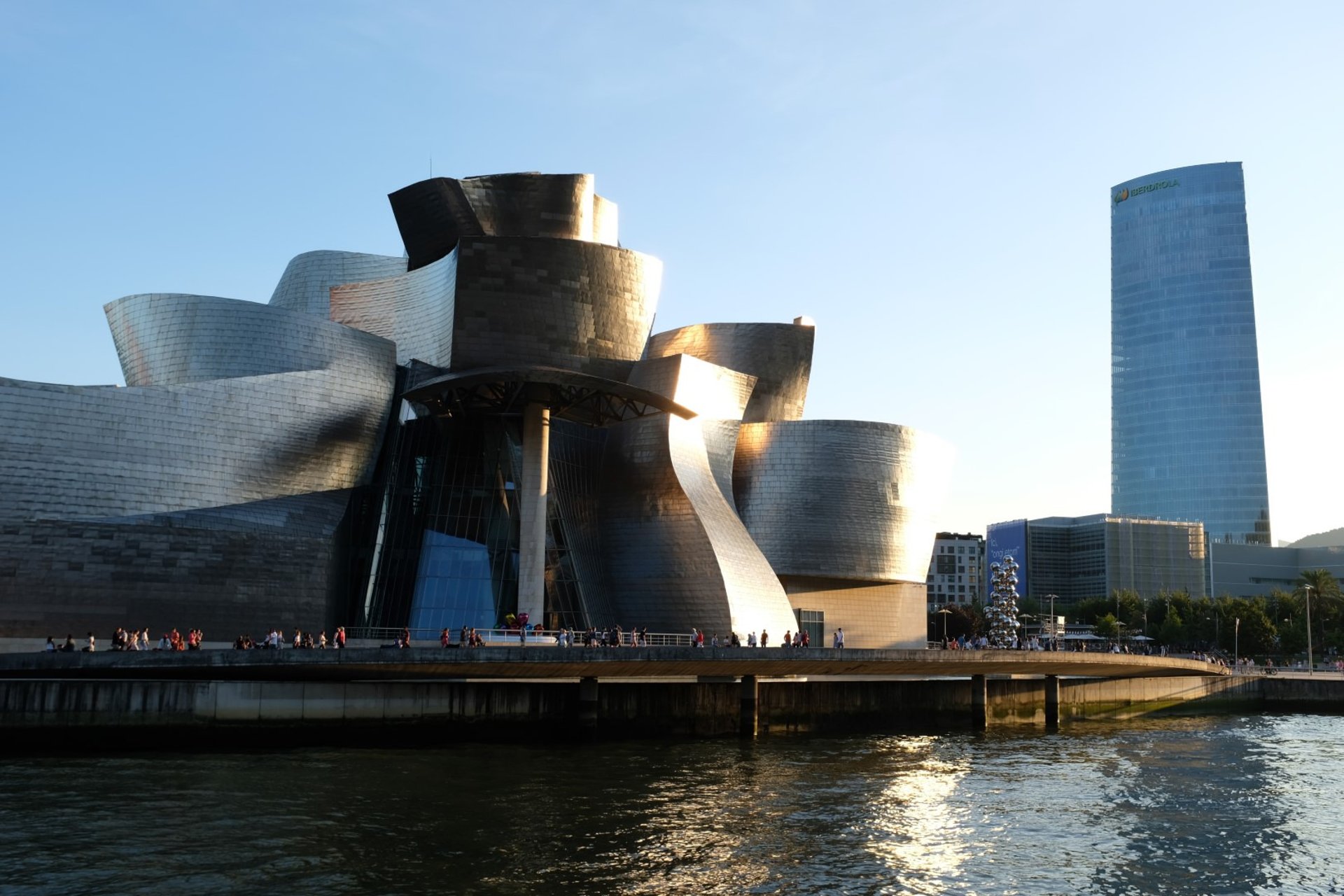
Basque in the Limelight
2018, Bilbao, Basque Country, Aste Nagusia, Guggenheim Museum, Gaztelugatxe
SPAINEUROPELANGUAGESMUSEUMSARTFESTIVALS
This summer I decided to take a step towards fixing that and booked a short course in Spain. Two weeks were what I had available, and I took some online self-assessment tests to work out what level to study at. I just needed to decide what part of Spain and what school to study with. I'd already visited Spain in 2012. Back then I'd just returned from a four-month trip through Africa, the Middle East and the Balkans and I wasn't sure what to do next. I'd gotten dissatisfied with wandering around and wanted some fixed goals, but I still had an appetite for foreign places. I was thinking of moving to Budapest, but first I wanted to make a short trip to Spain and see if I could find a city I liked as much there. I spent just a couple of days in Barcelona and Madrid and then went to Andalusia to see Málaga, Sevilla, Córdoba, Granada and Cádiz. As much as I liked these cities (especially the last two), in the end it remained just a visit and not the beginning of a move, and early the next year I was in Hungary. I never forgot about Spain though. Going back this year the gap on the map was clear to me—the North. I picked its largest and most famous city and centre of culture, Bilbao. It just so happened that a little before planning the trip I'd finished reading The Sun Also Rises, Ernest Hemingway's short novel centred on nearby Pamplona's fiesta. When my search for schools brought up Instituto Hemingway, I figured I'd smelt the whiff of destiny.
Ireland and Iberia
According to legend, the Greeks were born out of the soil of their country in the beginning. By contrast, in Irish mythology there's a striking acknowledgement that we are not indigenous to our island. According to the Lebor Gabála Érenn—The Book of the Taking of Ireland—the first human inhabitants came over the sea and forced the native fairy people, the Aos Sí, into the netherworld beneath the ground. Those first Gaels were led by one Míl Espáine, "a soldier of Spain", who sighted the island from a tower which looked north across the waves. I suppose this story caught wind much later in history, when Irish rebels were offering the island to the Catholic King Phillip II of Spain in return for military assistance against Elizabeth I. Wherever it ultimately came from, I always found this tradition of an affinity between Ireland and Spain interesting, and it might have planted the seed in my mind that eventually led me to studying the Spanish language. French and German still dominate in Irish school curricula, but I got a chance to experiment with Castellano in transition year, an optional vocational year in the Irish secondary school system between the junior and senior periods. I picked the language up again later in university, over the years I got a bit more disciplined, and today I have a decent intermediate grasp of the grammar and vocabulary. My speaking ability has always lagged behind though, which I suppose is what you get if you're only learning from books.
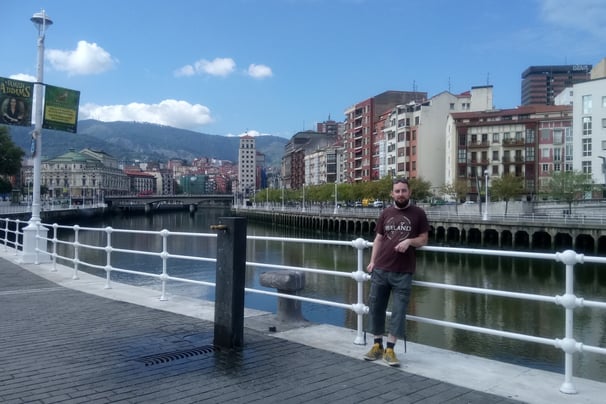

By the river in Bilbao
Semana Grande, or Aste Nagusia
By night, crowds on the way back down from Mount Artxanda
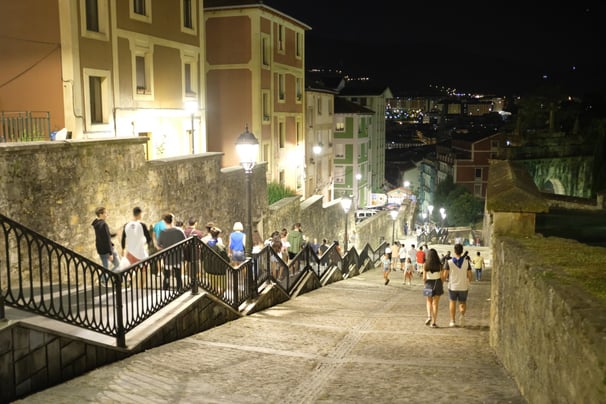

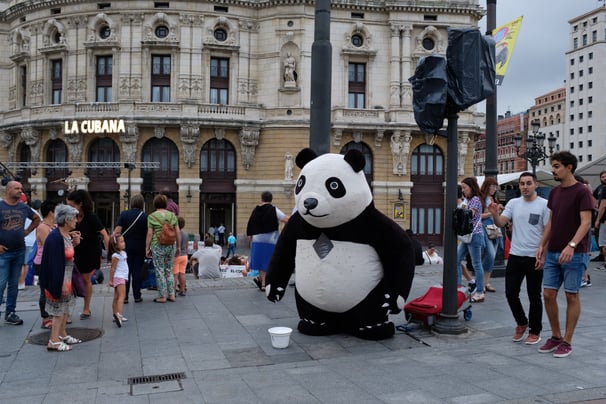

Bustling crowds in the Casco Viejo (Old Quarter)
I must have been smelling something alright. Shortly after arriving in Bilbao I found out I'd arrived right at the start of the city's own fiesta, Semana Grande, or Aste Nagusia in the Basque language. While each Spanish city does things a little differently, there was plenty to remind me of what I'd read. For nine days the normally peaceful city of Bilbao becomes a hive of activity, kicking off early each morning with a canon blast and the sounds of distant accordions. During the day the Casco Viejo (old quarter) gradually fills with crowds and musical bands of all genres march through the streets. I was especially blown away by a battalion of drummers blasting their way through the narrow streets on a Tuesday afternoon, competing for space with brass, bagpipes and Basque dancers in costume. You're only allowed to sleep after an explosive fireworks display has marked the pause in festivities each night. I heard one of these on my first night in the city, before I saw what was going on. It sounded like an artillery bombardment. I found out later that fireworks teams are invited in from all over Europe to compete against one another, and so each night there's something different to see. One of the most popular spots to watch the show from is Mount Artxanda.
Instituto Hemingway offers a program of social activities to all their students for free, including excursions to different places of interest in and around Bilbao, a paella night for the local version of the famous Catalan rice dish, and a Spanish wine tasting class. I especially enjoyed that last one, even though it happened to be whites that week. We got a crash course in the looking and the smelling before the drinking, and the different flavours from the fruit, the fermentation and the cask. We were also given an introduction to pintxos, the Basque version of tapas. The word comes from pinchar, "to pierce". Like tapas, these are light bites of meat, cheese and other goodies found in bars. Unlike tapas, they usually come skewered to a bread base rather than straight on the plate, and are not as easy to share. Tapas also traditionally come free with your drinks, whereas pintxos cost extra, though generally just a euro or two. When you walk into a bar you'll see a selection on display, so you can experiment away with chorizo sausage, mushrooms, goat's cheese or whatever else might take your fancy. A good spot to try Pintxos during the day is the cafeteria in the Mercado de la Ribera. For a great three course lunch I'd recommend La Mary at 3 Arriquíbar Plaza. I loved the food in Bilbao.
A view of the river from Instituto Hemingway
My language and culinary crash course at Instituto Hemingway
In the thick of the fiesta I was still determined to come in for lessons. I was placed in a B2 group, or upper intermediate (the CEFR – Common European Framework of Reference for Languages goes from A1 at lowest to C2 at the highest). As we got to know one another I noticed that the students seemed to fall into three categories. I and an older English lady were the hobby learners. Coming from affluent, comfortable countries, we enjoyed exploring the language and culture of Spain but didn't have any pressing need to do so. Then there were the professionals, a girl from China and another from Vietnam. They were both planning to put their Spanish to work in a multi-national. The most practically minded of all though were refugees. There were three guys in their twenties or thirties, one from Iraq, one from Palestine, and another from Western Sahara. Granted asylum in Spain, they needed Spanish to be able to integrate and work. I felt a note of embarrassment at the contrast in our stories as we took turns asking the old icebreaker, "Why Spanish?". It was only that month I'd started to see news articles identifying Spain as the new first port of call for migrants trying to enter Europe after efforts to constrict the Balkan route had begun to take effect. The new situation was tangible on the streets of Bilbao, where faces and voices from Africa and the Middle East mix with the local Basque hubbub. Khaled from Iraq had to leave after falling out with his family over his atheism. The other two guys were more reticent to get into details, not that there's much of a mystery when their home countries are being prevented from having a normal system of representative government. They were just some ordinary decent lads who could have been my classmates in transition year Spanish in another life. I hope they find what they're looking for in Europe.
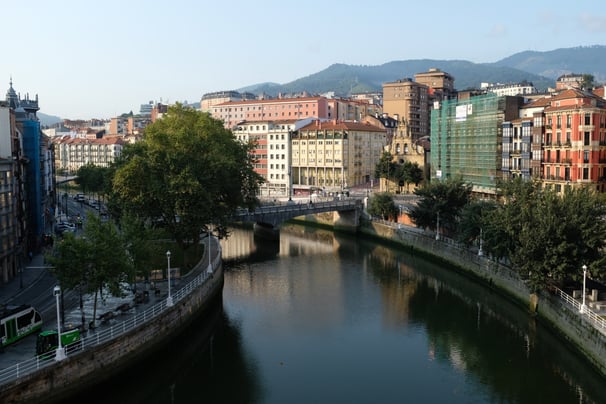

This city also offers a feast for the eyes, having made a name for itself in the world of modern art. A bit like black olives or prunes, that's something I used to think I could never get into. In the last few years though I've softened on it and actually gone the other direction. If you're not limited to creating something that looks like real life, how far can you go with colour and shape and still tickle someone's brain? And why does that tickle my brain that way? Is that what the artist had in mind? Does it matter? What's modern art anyway? And what's art while we're at it? Now I find these sorts of questions fun, but even if you don't agree I'd still recommend a visit to the Gugenheim. A little like Cork back home, Bilbao is a small town made grand by its hills, undulating up and down from the river. Here in a landscape of folds, twists and rolls, this extraordinary museum fits in better than it might have anywhere else. The glass, limestone and titanium exterior topples and turns like a pile of play dough or a scribble on a bored student's notepad. On your way in you're met by Jeff Koons' giant "Puppy" sculpture made of flowers, in-your-face but friendly like any good dog. Continuing into the atrium of the museum, your eyes are drawn up to the giant ceiling decorations, multi-coloured, organic looking sacks and tentacles, the inner organs of the building. Lights pulse through them at night, and if you peer in from the riverfront they almost seem to be pumping some kind of bodily fluid around the building. Fanning out from the atrium on the ground floor you'll find a crazy array of installations. This is a walk through wonderland—a giant ruby pendant spinning to the sound of Portuguese fado singing, a life-sized helicopter with pink plumage, mounted animal heads on the wall covered in lingerie lace. I was happy enough to find out that photos weren't allowed in these rooms. Funny as it might be to argue on this blog, without your camera in the way I do think you enjoy and engage more in the moment, and probably remember things better later on as well. But everything in moderation. From the second floor of the atrium I could take a few bird's-eye pictures of my favourite ground floor installation, Richard Serra's "The Matter of Time". This is a series of simple but room-sized steel shapes, big enough for multiple visitors to walk through and around. The title might give some hint about the artist's ideas, but in the end it's left up to the visitor to ponder.
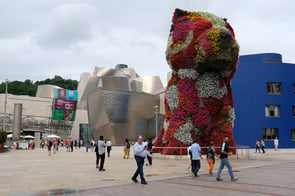
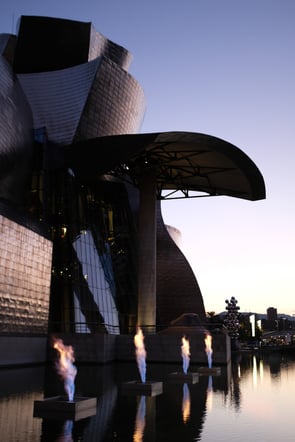
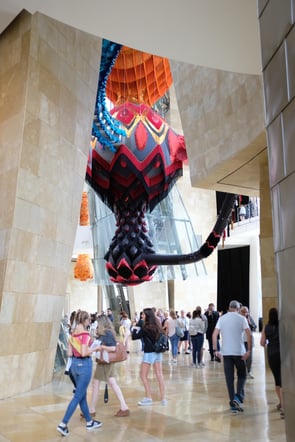
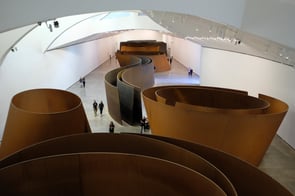




The paintings are on the upper floors. One I liked here was Mark Rothko's untitled piece. It's just yellow and orange, but it's very big, and standing in front of it you get a pleasant sense of a stretching horizon. Less minimalist and from a darker palette, I also liked the collection of works by Anselm Kiefer. In particular "The Renowned Orders of the Night" dominates its wall space and the entire room with an eerie gravity. The smallness of human beings in the universe, or of our lives and the great who-knows-what before and beyond come to mind—hefty stuff and dark territory, but I think it's good that artists explore it. In the same thread, you couldn't visit the Gugenheim without saying hello to Louise Bourgeois' "Maman". It's hard not to keep looking up at this thing to make sure it hasn't moved. For the best effect, come late, and you might want to watch Denis Villeneuve’s Enemy (2013) or Frank Darabont’s The Mist (2007) first for some extra nightmare-fuel. I was in luck, finishing my tour of the museum around eight, just before they started a surprise show. A thick mist was released from the pool in front of the museum, threatening to bring the spider to life. A little later they started up Yves Klein's "Fire Fountain". Without any warning and all of a sudden, five fiery jets shot up from a row of island furnaces in the pool. Jaws dropped all around and tourists leapt away from their seats—a few even screamed—before slowly regrouping for selfies. I watched the process repeat itself a couple of times.
Top left: "Puppy". Top right: Innards of the museum. Bottom left: "Fire Fountain". Bottom right: "The Matter of Time".
For even more art, the Museum of Fine Arts is a great gallery and entry is free every day from 18:00 to 20:00. This is the place to come to see Basque art, as well as some pieces from old masters like Sorolla and El Greco. If you walk by the river from the Gugenheim towards Casco Viejo you'll pass under La Salve Bridge with its striking red arch, and more modern art out in the open, dropped into the city's public spaces like a breadcrumb trail. Bilbao has marked itself in this way as forward-looking and inventive, but as the most important city in the Basque country it's also home to one of Europe's oldest pieces of living culture...
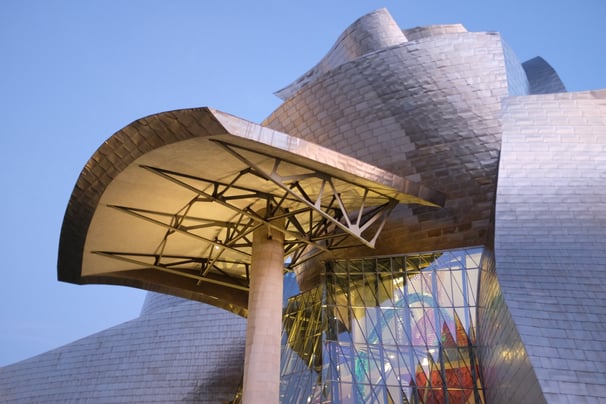

Gugenheim Museum Bilbao
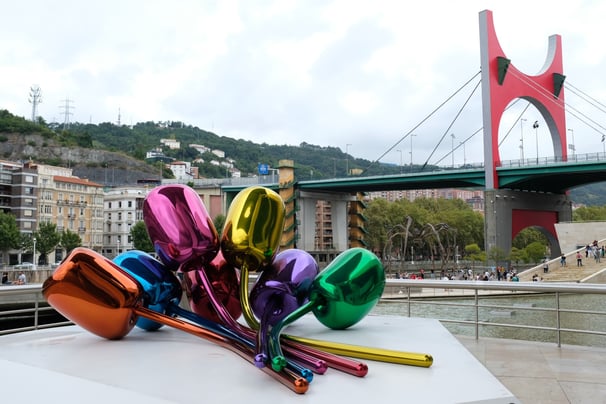

"Tulips" by Jeff Koons, one of the many pieces studding the river front. In the background, La Salve Bridge.
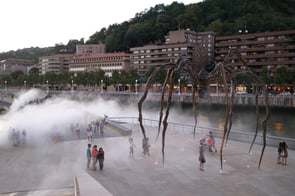
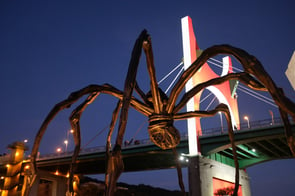


"Maman" shrouded in mist, and by night.
The Basque Language and Nationalism
The Basque language (Euskara) is a language isolate, meaning it's not known to be related to any other living tongue. Its lineage here probably goes back to long before the Celts or the Romans moved into Western Europe, possibly all the way back to the first Europeans who followed the retreat of the Ice Age glaciers northwards. It's a language of hard consonants that contrasts sharply with the smooth sounds of metropolitan Spanish. When my teacher sent me the results of my exam at the end of the course, he signed off with congratulations in the two languages, felicidades in Spanish, zorionak in Basque. I was so focused on Spanish, unfortunately I only picked up a handful of other phrases in Euskara, for example "welcome" is "ongi etorri" (constrast that with Spanish bienvenido).
Euskal Herria is the name the Basques give their country. Like in many parts of the world, language and ideas of nation are bound at the hip. The language, national flag and other social freedoms were repressed under Franco's dictatorship, giving rise to a violent separatist campaign waged by the organisation known as ETA from the late sixties until less than a decade ago. ETA have now officially disbanded, having lost legitimacy in the eyes of most Basques through their record of violence. Nationalist sentiment remains highly visible here however, with the Basque national flag, separatist banners, and statements of solidarity with Catalunya proudly displayed in the streets of Bilbao and beyond. Though I didn't experience it myself, I also heard a few anecdotes about locals who would refuse to speak Spanish, with foreigners or with other locals. On the one hand I understand the desire for local self-determination and the preservation of the culture and language, but at the same time a defensive chauvinism is still chauvinism. It also goes without saying that Franco is dead (if not dead and buried) and today's Spain is a very different place. In fact, by all accounts Euskara is making a comeback—thanks to immersion in school, it is now more widely spoken by teens than by the elderly. If the Basque country can achieve this kind of linguistic revival within Spain—something we’ve struggled to do in Ireland as an independent state—one of the main legs of the secessionist argument seems to me to wobble. You might well ask in response, would I argue for Ireland to rejoin the United Kingdom? I wouldn't, but it's worth pondering that if Ireland had never left, our continued presence in that union would have changed not only our own development, but that of our larger neighbour as well. How might we have altered the balance between Labour and the Conservatives? Between Remainers and Brexiteers? Who knows.
Day trips outside Bilbao
All that being said, simply looking at a map you get a visceral sense of the Basque country as something apart and distinct. It's in the place names. A great example is Gaztelugatxe, a mouthful of an islet in the Bay of Biscay, just to the north of Bilbao. Today this place has a new claim to fame as the filming location for Dragonstone castle in Game of Thrones (that's where Stanis used to hang out, or Daenerys' current base of operations, for anyone just tuning in). Even without the computer generated fortress or the dragons, this is a beautiful location just a short bus ride from Bilbao. Fans will recognise the narrow stone causeway connecting the island monastery to the mainland, once trodden by Tyrion Lannister and Jon Snow.
Travelling to the east of Bilbao you'll meet another exotic name in the province of Gipuzkoa, and its capital city of Donostia, probably better known abroad by its Spanish name—San Sebastián. I'd also heard of it from Hemingway, who came up here to swim after all his drinking in Pamplona. I came with a tour group organised by the school, again all included in the price of the course. We stopped along the way in the little town of Getaria, worth exploring for an hour or two if you're travelling along the same route. This is a strongly Basque speaking area, and there was a mild warning from our guide that some locals resent being spoken to in Spanish, though I didn't see any evidence of this myself. San Sebastián itself is a fairly straightforwardly beautiful little city, meeting a bay sheltered by islands with its long sandy beach. We had our lunch in the old town, and then walked along the beach as far as Peine del Viento. Meaning "The Comb of the Wind", these are a series of strange twisted iron sculptures by Eduardo Chillida, embedded in the rocks of the cape.
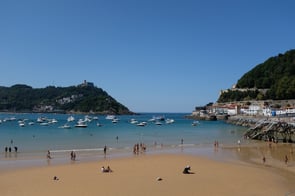
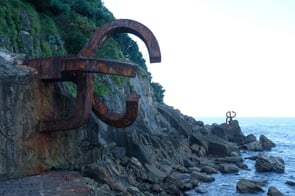


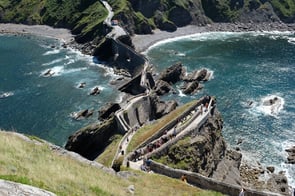



The beach at San Sebastián, and "The Comb of the Wind"
Gaztelugatxe
Bilbao to the beach
My most memorable bit of exploring on this trip though was back in Bilbao. I had my certificate of completion in my hands, and even though it had just been two weeks, I could sense the grammar humming in my brain and feel the words come a bit more quickly to my tongue. There was a threat of rain and none of my classmates wanted to go to the beach, but I knew it might be my last chance to see it. While the centre is nice to walk around, to get over Bilbao's hilly spots or to travel to the outer districts or the airport you can make use of the excellent public transport system which includes many bus lines and a metro. If you'll take more than a few trips it's worth getting a Barik card (also good for Gaztelugatxe). I took the metro from the centre to Portugalete and then went downhill on foot to the Puente Colgante, the Hanging Bridge. Officially called the Puente de Vizcaya or Bizkaiko Zubia, this is a transporter bridge connecting the picturesque waterfronts of the Portugalete and Getxo districts. A gondola suspended from the tall iron structure carries cars and pedestrians back and forth every few minutes. An impressive work of towering metal architecture as well as a practical way to cross the Nervion river, this is Spain's only UNESCO World Heritage Site in the Industrial Heritage category. You can pay for the crossing with your Barik card. The rain caught up with me while I was staring up at it, and for a minute I thought my day's exploring might be scuttled.
After a few minutes of drizzle though, the dark clouds moved on away to the north and the sun rallied. I crossed over to Getxo, and after enjoying the views of Portugalete behind me, I walked the short distance northwest to rejoin the metro at Areeta and travelled north to Sopela station. There are buses from the metro, but I decided to walk to the Arrietara Beach from there. It turned out to involve going up and down a couple of hills, but I had a grand short hike through the fields before coming to the sea. This is no Mediterranean coastline, and the Atlantic waves resounding along the beach draw many surfers as well as swimmers and strollers. Like any true Atlantic beach at home in Ireland, the wind barrels into you and fills up your lungs. Down on the sand, the sea seemed to hang in the air in a thick salty mist. The thunderstorm had missed the beach and was rolling from the sea in towards the city. It was like a big heavy curtain not quite reaching the floor; the line of the horizon underneath it a fiery red and orange with the sun going down. I picked out a headland to walk to, and when I got there I took out my compass to check the direction home, to Ireland across the Celtic sea.
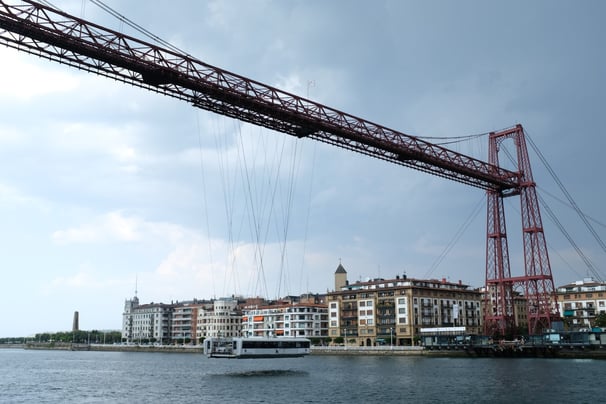


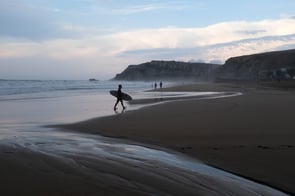


Puente Colgante, the Hanging Bridge
Evening views at Arrietara Beach
The Gist: Bilbao
ARRIVED: I flew to Bilbao with Aer Lingus from Dublin. The city is also served by low-costers such as Ryanair. There is also a ferry connection between Ireland (Rosslare) and Bilbao operated by Brittany Ferries, which I plan to use for any future return trips to northern Spain, thinking of my carbon footprint. From Bilbao, there are good rail and bus links to other cities in northern Spain as well as Madrid, and Biarritz in France. If you'll take more than a few trips within the city it's worth getting a Barik card for public transport in and around Bilbao. A shuttle bus connects the airport with the city centre.
SLEPT: I stayed in a shared apartment in the city centre organised by my school, Instituto Hemingway.
DID: My trip was centered around a short Spanish language course at Instituto Hemingway. The travel highlights for me in Bilbao were the Gugheim Museum, the city's river front, the Aste Nagusia festival, Puente Colgante, and the food culture, especially Pintxos! Venturing a little further out, I loved the beach at Arrietara, Gaztelugaxte. Going beyond Bilbao's hinterlands, San Sebastián was a great day trip.
LEFT: I flew back to Dublin with Aer Lingus.

